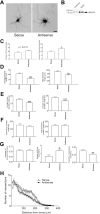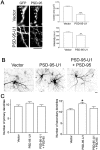Activity-independent regulation of dendrite patterning by postsynaptic density protein PSD-95
- PMID: 17021172
- PMCID: PMC6674632
- DOI: 10.1523/JNEUROSCI.2379-06.2006
Activity-independent regulation of dendrite patterning by postsynaptic density protein PSD-95
Abstract
Dendritic morphology determines many aspects of neuronal function, including action potential propagation and information processing. However, the question remains as to how distinct neuronal dendrite branching patterns are established. Here, we report that postsynaptic density-95 (PSD-95), a protein involved in dendritic spine maturation and clustering of synaptic signaling proteins, plays a novel role in regulating dendrite outgrowth and branching, independent of its synaptic functions. In immature neurons, overexpression of PSD-95 decreases the proportion of primary dendrites that undergo additional branching, resulting in a marked reduction of secondary dendrite number. Conversely, knocking down PSD-95 protein in immature neurons increases secondary dendrite number. The effect of PSD-95 is activity-independent and is antagonized by cypin, a nonsynaptic protein that regulates PSD-95 localization. Binding of cypin to PSD-95 correlates with formation of stable dendrite branches. Finally, overexpression of PSD-95 in COS-7 cells disrupts microtubule organization, indicating that PSD-95 may modulate microtubules to regulate dendritic branching. Whereas many factors have been identified which regulate dendrite number, our findings provide direct evidence that proteins primarily involved in synaptic functions can also play developmental roles in shaping how a neuron patterns its dendrite branches.
Figures









Similar articles
-
The role of PSD-95 and cypin in morphological changes in dendrites following sublethal NMDA exposure.J Neurosci. 2011 Oct 26;31(43):15468-80. doi: 10.1523/JNEUROSCI.2442-11.2011. J Neurosci. 2011. PMID: 22031893 Free PMC article.
-
A Novel Short Isoform of Cytosolic PSD-95 Interactor (Cypin) Regulates Neuronal Development.Mol Neurobiol. 2018 Aug;55(8):6269-6281. doi: 10.1007/s12035-017-0849-z. Epub 2018 Jan 2. Mol Neurobiol. 2018. PMID: 29294243 Free PMC article.
-
Overexpression of cypin alters dendrite morphology, single neuron activity, and network properties via distinct mechanisms.J Neural Eng. 2018 Feb;15(1):016020. doi: 10.1088/1741-2552/aa976a. J Neural Eng. 2018. PMID: 29091046 Free PMC article.
-
Glycerophospholipids - Emerging players in neuronal dendrite branching and outgrowth.Dev Biol. 2019 Jul 1;451(1):25-34. doi: 10.1016/j.ydbio.2018.12.009. Epub 2018 Dec 18. Dev Biol. 2019. PMID: 30576627 Review.
-
Extracellular molecular signals shaping dendrite architecture during brain development.Front Cell Dev Biol. 2023 Dec 7;11:1254589. doi: 10.3389/fcell.2023.1254589. eCollection 2023. Front Cell Dev Biol. 2023. PMID: 38155836 Free PMC article. Review.
Cited by
-
Novel phospho-switch function of delta-catenin in dendrite development.J Cell Biol. 2020 Nov 2;219(11):e201909166. doi: 10.1083/jcb.201909166. J Cell Biol. 2020. PMID: 33007084 Free PMC article.
-
RhoA regulates dendrite branching in hippocampal neurons by decreasing cypin protein levels.J Neurosci. 2007 Aug 1;27(31):8378-86. doi: 10.1523/JNEUROSCI.0872-07.2007. J Neurosci. 2007. PMID: 17670984 Free PMC article.
-
Acute Ethanol Exposure during Synaptogenesis Rapidly Alters Medium Spiny Neuron Morphology and Synaptic Protein Expression in the Dorsal Striatum.Int J Mol Sci. 2021 Dec 28;23(1):290. doi: 10.3390/ijms23010290. Int J Mol Sci. 2021. PMID: 35008713 Free PMC article.
-
PSD95 suppresses dendritic arbor development in mature hippocampal neurons by occluding the clustering of NR2B-NMDA receptors.PLoS One. 2014 Apr 4;9(4):e94037. doi: 10.1371/journal.pone.0094037. eCollection 2014. PLoS One. 2014. PMID: 24705401 Free PMC article.
-
Mitral Cell Dendritic Morphology in the Adult Zebrafish Olfactory Bulb following Growth, Injury and Recovery.Int J Mol Sci. 2024 May 5;25(9):5030. doi: 10.3390/ijms25095030. Int J Mol Sci. 2024. PMID: 38732248 Free PMC article.
References
-
- Aizawa H, Hu SC, Bobb K, Balakrishnan K, Ince G, Gurevich I, Cowan M, Ghosh A. Dendrite development regulated by CREST, a calcium-regulated transcriptional activator. Science. 2004;303:197–202. - PubMed
-
- Akum BF, Chen M, Gunderson SI, Riefler GM, Scerri-Hansen MM, Firestein BL. Cypin regulates dendrite patterning in hippocampal neurons by promoting microtubule assembly. Nat Neurosci. 2004;7:145–152. - PubMed
-
- Chen L, Chetkovich DM, Petralia RS, Sweeney NT, Kawasaki Y, Wenthold RJ, Bredt DS, Nicoll RA. Stargazin regulates synaptic targeting of AMPA receptors by two distinct mechanisms. Nature. 2000;408:936–943. - PubMed
Publication types
MeSH terms
Substances
Grants and funding
LinkOut - more resources
Full Text Sources
